The immediate idea that comes to mind is to use java.awt.Robot to capture a screen shot, paint that to frameless window. From there you can simply draw a rectangle on it
Updated with example
... Took some time ...

public class SelectionRectangle {
public static void main(String[] args) {
new SelectionRectangle();
}
public SelectionRectangle() {
EventQueue.invokeLater(new Runnable() {
@Override
public void run() {
try {
UIManager.setLookAndFeel(UIManager.getSystemLookAndFeelClassName());
} catch (ClassNotFoundException | InstantiationException | IllegalAccessException | UnsupportedLookAndFeelException ex) {
}
JFrame frame = new JFrame("Test");
frame.setUndecorated(true);
frame.setExtendedState(JFrame.MAXIMIZED_BOTH);
frame.setDefaultCloseOperation(JFrame.EXIT_ON_CLOSE);
frame.setLayout(new BorderLayout());
frame.add(new BackgroundPane());
frame.pack();
frame.setLocationRelativeTo(null);
frame.setVisible(true);
}
});
}
public class BackgroundPane extends JPanel {
private BufferedImage background;
private Point mouseAnchor;
private Point dragPoint;
private SelectionPane selectionPane;
public BackgroundPane() {
selectionPane = new SelectionPane();
try {
Robot bot = new Robot();
background = bot.createScreenCapture(getScreenViewableBounds());
} catch (AWTException ex) {
Logger.getLogger(SelectionRectangle.class.getName()).log(Level.SEVERE, null, ex);
}
selectionPane = new SelectionPane();
setLayout(null);
add(selectionPane);
MouseAdapter adapter = new MouseAdapter() {
@Override
public void mousePressed(MouseEvent e) {
mouseAnchor = e.getPoint();
dragPoint = null;
selectionPane.setLocation(mouseAnchor);
selectionPane.setSize(0, 0);
}
@Override
public void mouseDragged(MouseEvent e) {
dragPoint = e.getPoint();
int width = dragPoint.x - mouseAnchor.x;
int height = dragPoint.y - mouseAnchor.y;
int x = mouseAnchor.x;
int y = mouseAnchor.y;
if (width < 0) {
x = dragPoint.x;
width *= -1;
}
if (height < 0) {
y = dragPoint.y;
height *= -1;
}
selectionPane.setBounds(x, y, width, height);
selectionPane.revalidate();
repaint();
}
};
addMouseListener(adapter);
addMouseMotionListener(adapter);
}
@Override
protected void paintComponent(Graphics g) {
super.paintComponent(g);
Graphics2D g2d = (Graphics2D) g.create();
g2d.drawImage(background, 0, 0, this);
g2d.dispose();
}
}
public class SelectionPane extends JPanel {
private JButton button;
private JLabel label;
public SelectionPane() {
button = new JButton("Close");
setOpaque(false);
label = new JLabel("Rectangle");
label.setOpaque(true);
label.setBorder(new EmptyBorder(4, 4, 4, 4));
label.setBackground(Color.GRAY);
label.setForeground(Color.WHITE);
setLayout(new GridBagLayout());
GridBagConstraints gbc = new GridBagConstraints();
gbc.gridx = 0;
gbc.gridy = 0;
add(label, gbc);
gbc.gridy++;
add(button, gbc);
button.addActionListener(new ActionListener() {
@Override
public void actionPerformed(ActionEvent e) {
SwingUtilities.getWindowAncestor(SelectionPane.this).dispose();
}
});
addComponentListener(new ComponentAdapter() {
@Override
public void componentResized(ComponentEvent e) {
label.setText("Rectangle " + getX() + "x" + getY() + "x" + getWidth() + "x" + getHeight());
}
});
}
@Override
protected void paintComponent(Graphics g) {
super.paintComponent(g);
Graphics2D g2d = (Graphics2D) g.create();
g2d.setColor(new Color(128, 128, 128, 64));
g2d.fillRect(0, 0, getWidth(), getHeight());
float dash1[] = {10.0f};
BasicStroke dashed =
new BasicStroke(3.0f,
BasicStroke.CAP_BUTT,
BasicStroke.JOIN_MITER,
10.0f, dash1, 0.0f);
g2d.setColor(Color.BLACK);
g2d.setStroke(dashed);
g2d.drawRect(0, 0, getWidth() - 3, getHeight() - 3);
g2d.dispose();
}
}
public static Rectangle getScreenViewableBounds() {
GraphicsEnvironment ge = GraphicsEnvironment.getLocalGraphicsEnvironment();
GraphicsDevice gd = ge.getDefaultScreenDevice();
return getScreenViewableBounds(gd);
}
public static Rectangle getScreenViewableBounds(GraphicsDevice gd) {
Rectangle bounds = new Rectangle(0, 0, 0, 0);
if (gd != null) {
GraphicsConfiguration gc = gd.getDefaultConfiguration();
bounds = gc.getBounds();
Insets insets = Toolkit.getDefaultToolkit().getScreenInsets(gc);
bounds.x += insets.left;
bounds.y += insets.top;
bounds.width -= (insets.left + insets.right);
bounds.height -= (insets.top + insets.bottom);
}
return bounds;
}
}
Update with SnipIt Example
Some people have suggested using a transparent window laid over the top of the screen, this actually won't work, as transparent windows don't actually respond to mouse clicks UNLESS they have something to be painted on them that will allow the mouse event to be trapped.
It's also been suggested that you use a Window as the selection mechanism, this is a valid answer, however, I would (personally) find that to be an unsuitable solution, as you want the user to simply click and drag the selection rectangle (IMHO).
Another approach is use something like SnipIt.

public class SnipIt {
public static void main(String[] args) {
new SnipIt();
}
public SnipIt() {
EventQueue.invokeLater(new Runnable() {
@Override
public void run() {
try {
UIManager.setLookAndFeel(UIManager.getSystemLookAndFeelClassName());
} catch (ClassNotFoundException | InstantiationException | IllegalAccessException | UnsupportedLookAndFeelException ex) {
}
JFrame frame = new JFrame();
frame.setUndecorated(true);
// This works differently under Java 6
frame.setBackground(new Color(0, 0, 0, 0));
frame.setDefaultCloseOperation(JFrame.EXIT_ON_CLOSE);
frame.setLayout(new BorderLayout());
frame.add(new SnipItPane());
frame.setBounds(getVirtualBounds());
frame.setVisible(true);
}
});
}
public class SnipItPane extends JPanel {
private Point mouseAnchor;
private Point dragPoint;
private SelectionPane selectionPane;
public SnipItPane() {
setOpaque(false);
setLayout(null);
selectionPane = new SelectionPane();
add(selectionPane);
MouseAdapter adapter = new MouseAdapter() {
@Override
public void mousePressed(MouseEvent e) {
mouseAnchor = e.getPoint();
dragPoint = null;
selectionPane.setLocation(mouseAnchor);
selectionPane.setSize(0, 0);
}
@Override
public void mouseDragged(MouseEvent e) {
dragPoint = e.getPoint();
int width = dragPoint.x - mouseAnchor.x;
int height = dragPoint.y - mouseAnchor.y;
int x = mouseAnchor.x;
int y = mouseAnchor.y;
if (width < 0) {
x = dragPoint.x;
width *= -1;
}
if (height < 0) {
y = dragPoint.y;
height *= -1;
}
selectionPane.setBounds(x, y, width, height);
selectionPane.revalidate();
repaint();
}
};
addMouseListener(adapter);
addMouseMotionListener(adapter);
}
@Override
protected void paintComponent(Graphics g) {
super.paintComponent(g);
Graphics2D g2d = (Graphics2D) g.create();
Rectangle bounds = new Rectangle(0, 0, getWidth(), getHeight());
Area area = new Area(bounds);
area.subtract(new Area(selectionPane.getBounds()));
g2d.setColor(new Color(192, 192, 192, 64));
g2d.fill(area);
}
}
public class SelectionPane extends JPanel {
private JButton button;
private JLabel label;
public SelectionPane() {
button = new JButton("Close");
setOpaque(false);
label = new JLabel("Rectangle");
label.setOpaque(true);
label.setBorder(new EmptyBorder(4, 4, 4, 4));
label.setBackground(Color.GRAY);
label.setForeground(Color.WHITE);
setLayout(new GridBagLayout());
GridBagConstraints gbc = new GridBagConstraints();
gbc.gridx = 0;
gbc.gridy = 0;
add(label, gbc);
gbc.gridy++;
add(button, gbc);
button.addActionListener(new ActionListener() {
@Override
public void actionPerformed(ActionEvent e) {
SwingUtilities.getWindowAncestor(SelectionPane.this).dispose();
}
});
addComponentListener(new ComponentAdapter() {
@Override
public void componentResized(ComponentEvent e) {
label.setText("Rectangle " + getX() + "x" + getY() + "x" + getWidth() + "x" + getHeight());
}
});
}
@Override
protected void paintComponent(Graphics g) {
super.paintComponent(g);
Graphics2D g2d = (Graphics2D) g.create();
// I've chosen NOT to fill this selection rectangle, so that
// it now appears as if you're "cutting" away the selection
// g2d.setColor(new Color(128, 128, 128, 64));
// g2d.fillRect(0, 0, getWidth(), getHeight());
float dash1[] = {10.0f};
BasicStroke dashed =
new BasicStroke(3.0f,
BasicStroke.CAP_BUTT,
BasicStroke.JOIN_MITER,
10.0f, dash1, 0.0f);
g2d.setColor(Color.BLACK);
g2d.setStroke(dashed);
g2d.drawRect(0, 0, getWidth() - 3, getHeight() - 3);
g2d.dispose();
}
}
public static Rectangle getVirtualBounds() {
Rectangle bounds = new Rectangle(0, 0, 0, 0);
GraphicsEnvironment ge = GraphicsEnvironment.getLocalGraphicsEnvironment();
GraphicsDevice lstGDs[] = ge.getScreenDevices();
for (GraphicsDevice gd : lstGDs) {
bounds.add(gd.getDefaultConfiguration().getBounds());
}
return bounds;
}
}



